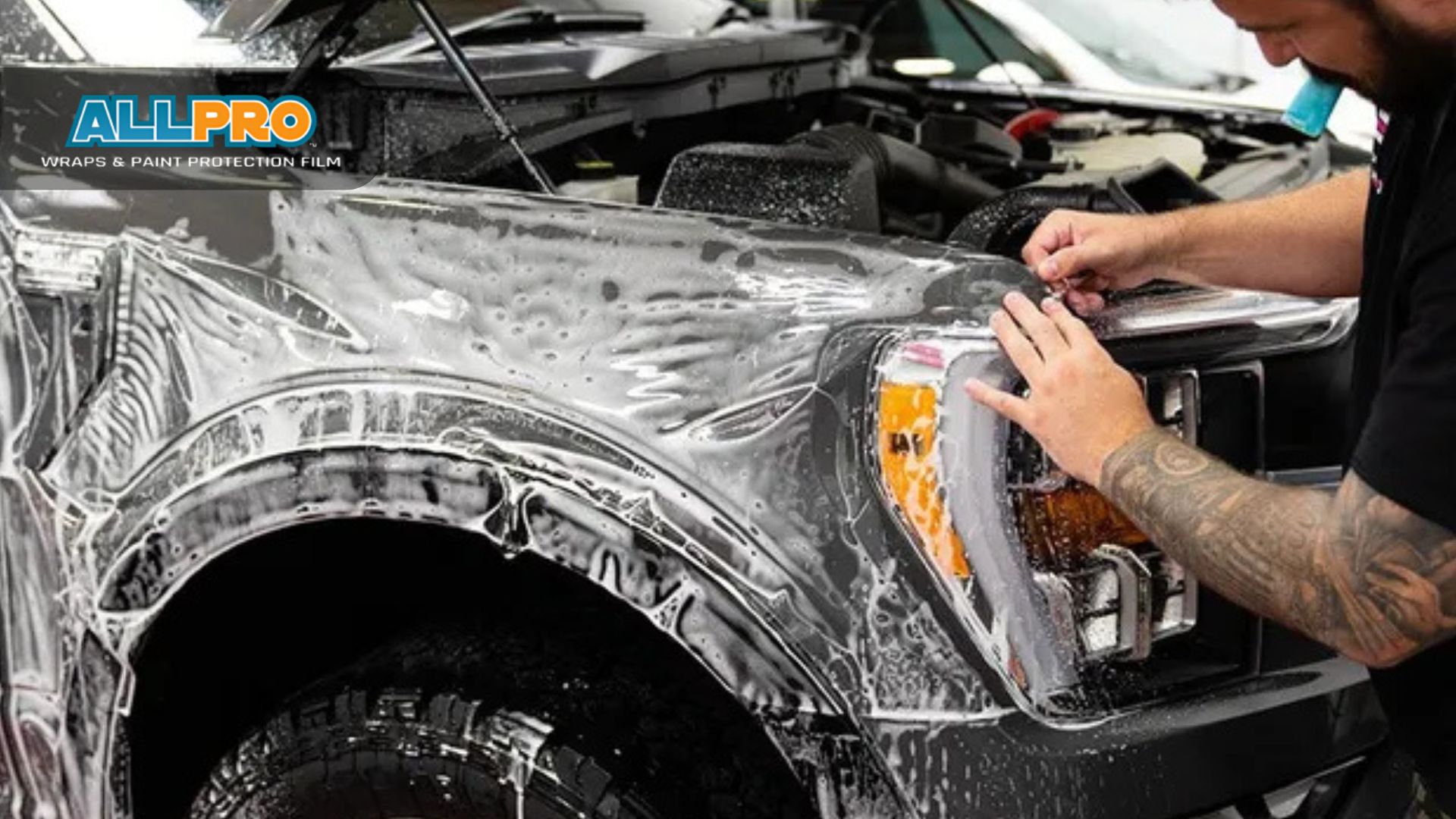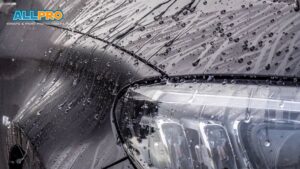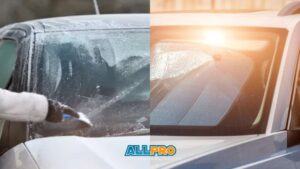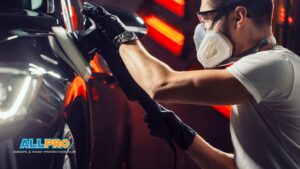Raleigh winters may not bring the heavy snowstorms of the Northeast, but they still pose a threat to your vehicle’s paint. Freezing temperatures, occasional snow, ice, and road salt can cause gradual damage that’s easy to overlook—until you start seeing chipped paint and corrosion.
North Carolina road crews often use salt and sand to prevent ice buildup, but these materials can grind against your car’s surface, leading to swirl marks, dull spots, and even rust over time. If you want to keep your car looking flawless through the winter months, choosing the right protection is crucial.
Understanding Paint Protection Film (PPF)
Paint Protection Film (PPF) is a clear, urethane film applied to a car’s exterior that serves as an invisible shield against harsh elements. Originally developed for military use to protect helicopter blades, it has since become one of the best solutions for preserving a vehicle’s paint against physical damage. Unlike ceramic coating, which enhances shine and makes cleaning easier, PPF is specifically designed to absorb impacts and protect against abrasions.
Key Benefits for Raleigh Winters
-
- Shields against rock chips and road salt – Common on highways like I-40 and I-540, where road maintenance crews spread salt and gravel to prevent ice buildup.
-
- Self-healing properties – Minor scratches from ice scraping or road debris can disappear with heat exposure.
-
- Maximum impact resistance – Essential for daily commuters driving on heavily used roads where loose gravel and debris are more likely.
-
- Ideal for outdoor parking – Protects against winter road grime, salt, and ice that can eat away at unprotected paint.
Potential Drawbacks
-
- Higher upfront cost – PPF is more expensive than ceramic coating, but its long-term durability can offset this initial investment.
- Requires professional installation – Unlike ceramic coatings that some car owners attempt to apply at home, PPF demands expert installation for a seamless finish and optimal performance.
Understanding Ceramic Coating
Ceramic coating is a liquid polymer that chemically bonds to the car’s paint, forming a hydrophobic (water-repellent) layer. While it doesn’t provide impact resistance like Paint Protection Film, it offers excellent protection against oxidation, UV rays, and chemical stains from road salt. Think of it as a high-tech wax that lasts for years instead of months. This makes it an attractive option for those who want to keep their car looking sleek while reducing maintenance time.
Key Benefits for Raleigh Winters
-
- Easier to clean – The slick surface prevents dirt and road salt from sticking, making washes faster and more effective.
-
- UV protection – Raleigh winters may bring cold temperatures, but the sun still beats down. Ceramic coatings help prevent fading and oxidation from prolonged UV exposure.
-
- Prevents water spots – Melting snow and ice can leave behind hard water spots, but ceramic coatings reduce this risk by repelling moisture.
- Enhances shine – If you want your car to maintain that showroom-like gloss, ceramic coating provides a deep, glossy finish year-round.
Potential Drawbacks
-
- No impact resistance – Ceramic coating won’t stop rock chips or prevent physical damage from road debris.
-
- Requires proper maintenance – To keep its effectiveness, the coating should be hand-washed with pH-neutral shampoos and maintained periodically.
How Long Do PPF and Ceramic Coating Last in Raleigh?
Durability is one of the biggest factors to consider when choosing between Paint Protection Film (PPF) and Ceramic Coating. While both options provide excellent protection, they have different lifespans and maintenance requirements, especially in Raleigh’s climate.
A high-quality PPF installation can last anywhere from 5 to 10 years, depending on the brand, the quality of the film, and how well it’s maintained. Since PPF is designed to absorb impacts, its longevity can be affected by factors like frequent highway driving, exposure to road debris, and weather conditions.
Raleigh’s winter road treatments, including salt and sand, can wear down PPF over time, making proper maintenance essential. Regular washes and occasional inspections help ensure the film remains in top condition for years.
Ceramic Coating typically lasts between 2 and 5 years, depending on the quality of the coating and how well it’s maintained. Unlike PPF, Ceramic Coating doesn’t physically shield against impacts, but it provides long-term resistance against oxidation, UV damage, and chemical stains from road salt.
However, its effectiveness diminishes if the car isn’t washed properly or if abrasive cleaners are used. To maintain its hydrophobic properties, some ceramic coatings may require periodic top-ups or maintenance coats.
For drivers in Raleigh, the best long-term solution is often a combination of PPF and Ceramic Coating. PPF in high-impact areas provides long-lasting protection against road debris, while Ceramic Coating enhances shine and makes cleaning easier. Together, they extend the lifespan of your car’s paint protection, keeping your vehicle looking its best through every season.
Which is Better for Raleigh, NC Winters?
Both Paint Protection Film and Ceramic Coating offer distinct advantages, but the best choice depends on what kind of protection you need.
-
- For maximum winter protection – PPF is the best option. It acts as a physical barrier against rock chips, road salt, and debris, making it ideal for those who drive frequently on highways like I-40 and I-540.
-
- For easy maintenance and shine – Ceramic coating is a great choice. It repels dirt, water, and road grime, making it easier to wash off salt and winter contaminants while keeping the paint glossy.
-
- For the best of both worlds – Many Raleigh car owners opt for a combination of PPF and ceramic coating. A common approach is applying PPF to high-impact areas like the hood, bumper, and side mirrors while using ceramic coating on the rest of the car. This setup provides the best durability, ease of maintenance, and long-term protection.
So, which one is better suited for Raleigh’s unique winter conditions? If you want all-around protection that can handle road salt, gravel, and winter grime, a combination of PPF and ceramic coating is the best way to go.
Choosing the Best Protection for Your Car
Raleigh’s winters may not be the harshest, but they can still cause long-term damage to your vehicle’s paint if left unprotected. Road salt, ice, and freezing temperatures can lead to chipping, corrosion, and dull paint over time.
Paint Protection Film is the best choice if you’re looking for maximum physical protection against rock chips, road debris, and salt damage. Its impact resistance makes it ideal for daily commuters and those who drive frequently on highways where winter road conditions can be rough on a car’s exterior.
Ceramic Coating, on the other hand, is an excellent solution for ease of maintenance and long-lasting shine. It repels dirt, water, and road salt, making it easier to wash your car and keep it looking sleek throughout the season. While it won’t prevent physical damage like PPF, it provides superior resistance to oxidation and chemical stains caused by winter conditions.
For the best results, combining both options ensures comprehensive protection through Raleigh’s changing seasons. A layer of PPF in high-impact areas combined with Ceramic Coating over the rest of the car provides durability, shine, and ease of maintenance.
If you’re ready to protect your car this winter, contact AllPro Wraps for expert installation of PPF, Ceramic Coating, or both. Our team can help you find the best solution for your vehicle and ensure it stays protected all year long.





